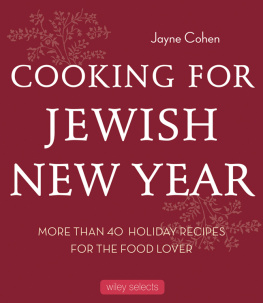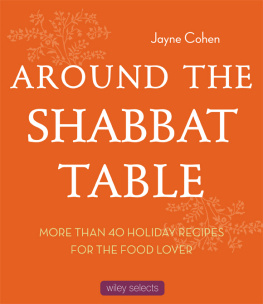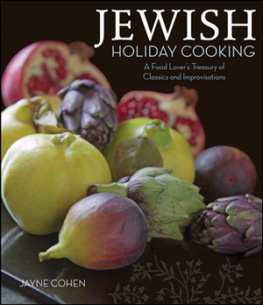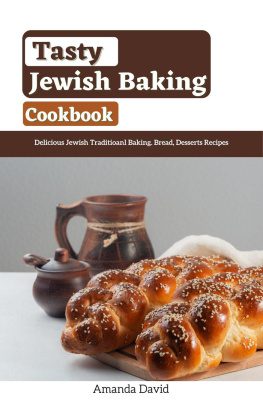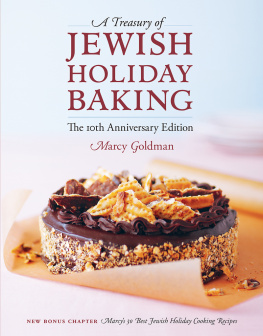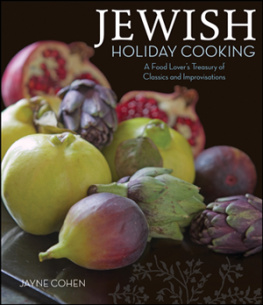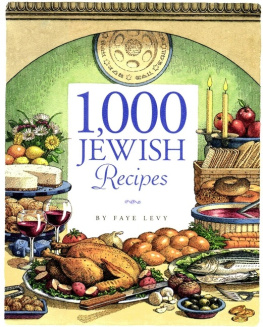Cooking for Jewish New Year
40 Holiday Recipes for the Food Lover
Jayne Cohen
Wiley Selects

This book is printed on acid-free paper.
Copyright 2012 by Jayne Cohen. All rights reserved.
Published by John Wiley & Sons, Inc., Hoboken, New Jersey.
Published simultaneously in Canada.
No part of this publication may be reproduced, stored in a retrieval system, or transmitted in any form or by any means, electronic, mechanical, photocopying, recording, scanning, or otherwise, except as permitted under Section 107 or 108 of the 1976 United States Copyright Act, without either the prior written permission of the Publisher, or authorization through payment of the appropriate per-copy fee to the Copyright Clearance Center, Inc., 222 Rosewood Drive, Danvers, MA 01923, 9787508400, fax 9786468600, or on the web at www.copyright.com. Requests to the Publisher for permission should be addressed to the Permissions Department, John Wiley & Sons, Inc., 111 River Street, Hoboken, NJ 07030, 2017486011, fax 2017486008, or online at http://www.wiley.com/go/permissions.
Limit of Liability/Disclaimer of Warranty: While the publisher and author have used their best efforts in preparing this book, they make no representations or warranties with respect to the accuracy or completeness of the contents of this book and specifically disclaim any implied warranties of merchantability or fitness for a particular purpose. No warranty may be created or extended by sales representatives or written sales materials. The advice and strategies contained herein may not be suitable for your situation. You should consult with a professional where appropriate. Neither the publisher nor author shall be liable for any loss of profit or any other commercial damages, including but not limited to special, incidental, consequential, or other damages.
For general information on our other products and services, or technical support, please contact our Customer Care Department within the United States at 8007622974, outside the United States at 3175723993 or fax 3175724002.
Wiley publishes in a variety of print and electronic formats and by print-on-demand. Some material included with standard print versions of this book may not be included in e-books or in print-on-demand. If this book refers to media such as a CD or DVD that is not included in the version you purchased, you may download this material at http://booksupport.wiley.com. For more information about Wiley products, visit www.wiley.com.
Library of Congress Cataloging-in-Publication Data is available upon request.
ISBN 978-1-118-38884-6 (ebk); ISBN 978-1-118-38886-0 (ebk)
Printed in the United States of America
10 9 8 7 6 5 4 3 2 1

ROSH HASHANAH
1 AND 2 TISHRI (SEPTEMBER OR OCTOBER)
The pineapple groans under her sharp knife like a live fish. Its juice, like white blood, trickles onto my fingers. I lick them. It is a tart-sweet taste.
Is this the taste of the New Year?
BELLA CHAGALL, Burning Lights
Rosh Hashanah celebrates both the New Year and a birthdayhumankinds. But in place of revelry, there is reflection; instead of joyful music, the shrill wail of the shofar summons us to cleanse our souls and our hearts.
For Rosh Hashanah is the Day of Judgment, when God inscribes our fate for the coming year in the Book of Life. The decree, however, is not final: the book is shut, the judgment sealed on Yom Kippur. So we can change our destiny during the next ten days, the Days of Awe, with prayer, charity, and reparation of the wrongdoings we have committed against others.
Judaism teaches that God created the world, but left it not quite finished, so that we could become the Makers partners in the creative process by completing the work. This process is called tikkun olam (literally, the repair of the world), and it is by bettering ourselves and restoring what is damaged and imperfect in life that we honor and celebrate the birth of Creation.
The holiday is at once solemn and festive: joy comes not only from trust in Gods compassion but also the anticipation of renewal and fresh starts. Nearly 2,500 years ago, the prophet Nehemiah proclaimed, Eat the rich and drink the sweet.
That sweet, rich Rosh Hashanah meal becomes more than mere rejoicingit too is a form of prayer. The table is transformed into an altar to supplicate God, as we partake of symbolic foods embodying our wishes: honeyed and sugared treats for a sweet year; round foods for a fulfilled year, unbroken by tragedy; foods that grow in profusion at this season and those eaten in abundance, like rice, signifying hopes for fecundity, prosperity, and a wealth of merits.
Rosh Hashanah is also known as the Day of Remembrance, and eating these special dishes reminds us how we must behave. Whole or part of an animals head (sweetbreads, tongue, etc.); an entire fish, including the head; or even a head of roasted garlic might be served, urging us to be a model of righteousness, at the head of our peers. Sweets, like challah stuffed with raisins, tell us to act in a way that would cause no sadness.
We begin dinner with a prayer for a sweet year, dipping challah (or other sweet bread) and apples into fragrant honey. Other families start with sugared pomegranates, dates, figs, or quince in rose petal syrupor even, as at least one family with young children does, with challah and apples in chocolate sauce! Cochini Jews may have twenty fruits on the table and dip each one.
Fish, symbolizing fertility and Gods blessings, is the customary first course on most menus. Rapid-growing seasonal vegetables like leeks, Swiss chard, black-eyed peas, and pumpkinsto name just a fewappear throughout the meal in major roles and supporting parts. Sumptuous main dishes follow, and usually, two (or more) sweet desserts, like a simple, fresh plum tart, a honey cake, or a noodle kugellush with coconut milk and caramelized pineappleconclude the meal.
For me, no Rosh Hashanah custom captures the joy of creation, of life, like the new fruit ritual, when a fruit is tasted for the first time since it was last in season. We decide on a special fruit, but refrain from eating it when it arrives at our local markets in late summer or early autumn. Then, when Rosh Hashanah comes, it is as if we are tasting the fruit for the first time. Usually we cut open a pomegranate or two and spoon the seeds into little crystal bowls. Often I have not eaten this favorite fruit since last January; tasting it on Rosh Hashanah is like discovering it, participating in the brand-newness of Creation. This is the thrill expressed in the Sheheheyonu prayer, traditionally recited on Rosh Hashanah and other occasions when one experiences the pleasure of lifes extraordinary moments, what Anita Diamant, author of The Red Tent, calls the wow prayer.
One year, as we all held hands and recited the prayer, a tear rolled down a guests cheek. The Sheheheyonu, he remembered, had been his late fathers favorite blessing, and he had never understood why. Now, hearing it chanted again for the first time in twenty-five years, he finally understood.

Dinners on the first and second nights of the holiday (Reform Jews celebrate the first night only) are not the only times we enjoy the festive foods. Many families host special lunches after synagogue services on the first and second days. At my late mother-in-laws annual Rosh Hashanah open house, an extended bar and several buffet areas were set up throughout her sprawling Brooklyn apartment to accommodate all the family and friends who would show up at different times from various synagogues. For us, those luncheons signaled the end of the long summer, a day to reconnect, note the changes that had taken place in the past year, and make plans together for the year to come.

